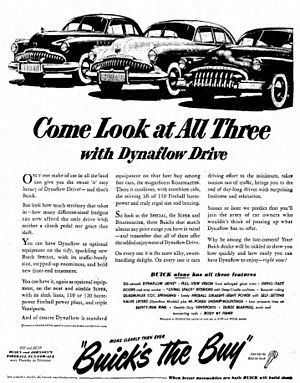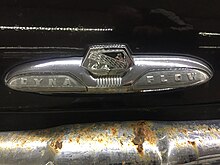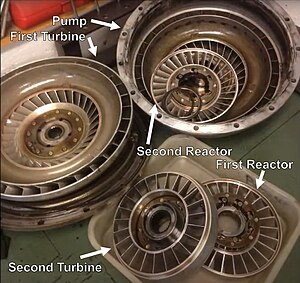
An automatic transmission is a multi-speed transmission used in motor vehicles that does not require any input from the driver to change forward gears under normal driving conditions. Vehicles with internal combustion engines, unlike electric vehicles, require the engine to operate in a narrow range of rates of rotation, requiring a gearbox, operated manually or automatically, to drive the wheels over a wide range of speeds.

A torque converter is a device, usually implemented as a type of fluid coupling, that transfers rotating power from a prime mover, like an internal combustion engine, to a rotating driven load. In a vehicle with an automatic transmission, the torque converter connects the prime mover to the automatic gear train, which then drives the load. It is thus usually located between the engine's flexplate and the transmission. The equivalent device in a manual transmission is the mechanical clutch.

The Buick LeSabre is a full-size car made by the division Buick of General Motors from 1959 until 2005. Prior to 1959, this position had been retained by the full-size Buick Special model (1936–58). The "LeSabre", which is French for "the sabre", was Buick's mid-level full-size sedan above the Special but below the Electra during the 1960s then remained in its market position when the Electra was replaced with the Park Avenue. The LeSabre was available as a 2-door convertible, sedan or hardtop, a 4-door sedan or hardtop and station wagon throughout its production.

Hydramatic is an automatic transmission developed by both General Motors' Cadillac and Oldsmobile divisions. Introduced in 1939 for the 1940 model year vehicles, the Hydramatic was the first mass-produced fully-automatic transmission developed for passenger automobile use.

TorqueFlite is the trademarked name of Chrysler Corporation's automatic transmissions, starting with the three-speed unit introduced late in the 1956 model year as a successor to Chrysler's two-speed PowerFlite. In the 1990s, the TorqueFlite name was dropped in favor of alphanumeric designations, although the latest Chrysler eight-speed automatic transmission has revived the name.
Ultramatic was the trademarked name of the Packard Motor Car Company's automatic transmission introduced in 1949 and produced until 1954, at Packard's Detroit, Michigan, East Grand Boulevard factory. It was produced thereafter from late 1954, thru 1956 at the new Packard "Utica" Utica, Michigan facility.
Turbo-Hydramatic or Turbo Hydra-Matic is the registered tradename for a family of automatic transmissions developed and produced by General Motors. These transmissions mate a three-element turbine torque converter to a Simpson planetary geartrain, providing three forward speeds plus reverse.
The Powerglide is a two-speed automatic transmission designed by General Motors. It was available primarily on Chevrolet from January 1950 through 1973, although some Pontiac models also used this automatic transmission after the fire at the Hydra-Matic factory in 1953. Powerglides were used extensively on Pontiacs produced for the Canadian market with Chevrolet powertrains. They were also used with Nova engines in the DJ-5A Jeeps produced 1968-1970 by Kaiser-Jeep and widely used as delivery vehicles by the United States Post Office. When introduced on upper-level Chevrolet models in 1950, the Powerglide represented the first automatic transmission offered in a low-priced automobile; in contrast, Ford did not offer their automatic transmission until 1951, while Plymouth car buyers had to wait until 1954. The transmission was simple and very durable, which satisfied customers.
Roto Hydramatic was an automatic transmission built by General Motors and used in some Oldsmobile, Pontiac and Holden models between 1961 and 1965. It was based on the earlier, four-speed Hydramatic, but was more compact, providing only three forward speeds plus a small 8" fluid coupling with a stator inside of the fluid coupling. Oldsmobile, one of the companies that used this transmission in some of its cars, called the fluid couplings stator the "Accel-A-Rotor." The lightweight, aluminum-cased transmission was sometimes nicknamed the "Slim Jim." HydraMatic Division calls the Roto a four-range, three-gear HydraMatic.
The Super Turbine 300 was a two-speed automatic transmission built by General Motors. It was used in various Buick, Oldsmobile, and Pontiac models from 1964-1969. It was the same transmission marketed under different brand names by each division including ST-300 by Buick, Jetaway by Olds and simply Automatic by Pontiac.

The 4T80E is a series of automatic transmissions from General Motors. Designed for transverse engine configurations, the series includes 4 forward gears. The 4Txx family is an evolution of the original Turbo-Hydramatic 125 transverse automatic introduced in the 1980 model year "X" body.
The 4L60E is a series of automatic transmissions from General Motors. Designed for longitudinal engine configurations, the series includes 4 forward gears and 1 reverse gear. The 4L60E is the electronically commanded evolution of the Turbo-Hydramatic 700R4, originally produced in 1982.

The Turbo-Hydramatic 125 was the first in a line of automatic transmissions from General Motors designed for transverse engine application. Introduced in 1980, the line evolved into today's 4T40/45/65/80 line.
The 4T60-E is a series of automatic transmissions from General Motors. Designed for transverse engine configurations, the series includes 4 forward gears. The 4Txx family is an evolution of the original Turbo-Hydramatic 125 transverse automatic introduced in the late 1970s and the Turbo-Hydramatic 440 transmission developed in the mid-1980s.
A transmission control unit (TCU), also known as a transmission control module (TCM), or a gearbox control unit (GCU), is a type of automotive ECU that is used to control electronic automatic transmissions. Similar systems are used in conjunction with various semi-automatic transmissions, purely for clutch automation and actuation. A TCU in a modern automatic transmission generally uses sensors from the vehicle, as well as data provided by the engine control unit (ECU), to calculate how and when to change gears in the vehicle for optimum performance, fuel economy and shift quality.
The Hy-Drive was a Chrysler Corporation semi-automatic transmission introduced in 1953 in US-market Plymouths. It was a hybrid manual transmission equipped with a torque converter, like an automatic. Although Hy-Drive cars had a clutch pedal like a traditional manual transmission, it was only used to put the car in gear. Once underway, the driver could upshift and downshift using the gear shift without using the clutch or even lifting off the accelerator.
Fluid Drive is the trademarked name that Chrysler Corporation assigned to a transmission driveline combination which replaced the flywheel with a hydraulic coupling and performed the same function as a modern torque converter, only without torque multiplication. A conventional clutch and three- or four-speed manual transmission was installed behind the fluid coupling. Fluid drive was used in many military vehicles produced for the US Armed Forces during the Second World War. It was offered for civilian use from 1939 through 1953 in Chryslers, 1940 through 1953 in DeSotos, and from 1941 through 1954 in Dodge models; a semi-automatic system was optional from Chrysler and Desoto from 1941, and for Dodge from 1949.
The Turboglide is a Chevrolet constant torque, continuously variable automatic transmission first offered as an option on Chevrolet V8 passenger cars for 1957. It consisted of a turbine-driven planetary gearbox with a 'switch pitch' dual-pitch torque converter stator. It had a die-cast aluminum transmission case, like Packard's Ultramatic of 1956. Turboglide cost about $50 more than the Powerglide 2-speed automatic. It was available in all V8-powered 1957-1961 Chevrolet models except the Corvette. General Motors produced 646,000 of these transmissions during its production.

Chevrolet Corvair Powerglide is a two-speed automatic transmission designed specially for the then all-new 1960 Chevrolet Corvair compact car that emerged in the fall of 1959 as Chevrolet's competitor in the then booming small car market. The Corvair was powered by a rear-mounted Chevrolet Turbo-Air 6 engine that necessitated a specially designed transaxle. Corvair Powerglide took the principles of the standard Chevrolet Powerglide and modified them to suit the rear-mounted powertrain location of the new Corvair. The Corvair used the Powerglide for all 10 years it was produced; from 1961 to 1963, Pontiac used a modified version of Corvair Powerglide it called 'TempesTorque' for its front-engine, rear-transaxle Tempest, LeMans and Tempest LeMans cars.










